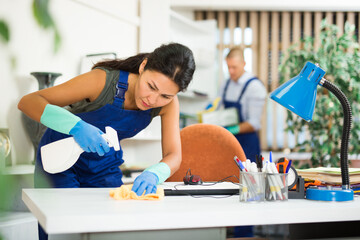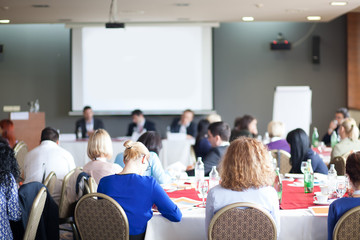Maintaining a clean office is not only an aesthetic preference, it also protects employees from health risks. Having cleaning products readily available, such as brooms, dustpans, soap, paper towels and disinfectant wipes, makes the task much easier for staff.
Personal offices and cubicles should be wiped down daily, while trash cans should be emptied on a regular basis. Disinfectant sprays can be used to wipe down high-touch areas like drawer handles and phone handsets. Contact Office Cleaning Winnipeg for professional help.
1. Declutter Your Desks
 Cluttered desks are a huge distraction and are a big reason for poor productivity. If your desk is full of piles of old paperwork, pens and pencils, lunch leftovers and more, it can be difficult to think clearly.
Cluttered desks are a huge distraction and are a big reason for poor productivity. If your desk is full of piles of old paperwork, pens and pencils, lunch leftovers and more, it can be difficult to think clearly.
The best way to declutter your desk is to start with a total purge. Empty your desk, filing system and drawers. Sort through the items and decide what to keep, file and toss. Try to be ruthless with paper-anything you can access digitally doesn’t need to take up space on your desk. Also, be sure to use dividers in your drawers to keep things organized. For example, keep pens and paper clips in one section and tape and scissors in another.
Once you’ve purged, take the time to clean your desk. This is a great opportunity to get rid of old coffee mugs, office supplies and other clutter that you don’t really need or use.
You should also dust your keyboard and monitor, especially if you work in an open area. It’s also important to remove distracting posters and pictures from your wall. If you have a chair, be sure to wipe it down with a disinfectant wipe. This will help to prevent germs from spreading to other parts of your workspace.
If you want to make keeping a clean desk a regular practice, schedule 10 to 15 minutes daily to clear off your desktop and other surfaces. This will prevent clutter from building up and can improve your focus. In addition, regular decluttering can give you a better reputation in the office by signaling that you’re efficient and thorough. This can lead to better relationships with co-workers and a more productive workplace overall.
2. Keep Your Workspace Organized
A cluttered workspace can distract employees and prevent them from completing tasks in a timely manner. It’s important for managers to create a clean, organized workplace to ensure their team can perform its best. This will help boost employee morale and productivity, which is essential for the success of a business.
The first step in keeping your workspace clean is to remove all items from your desk. This will give you a clear view of what remains, making it easier to keep it tidy. Afterward, arrange items in zones based on their frequency of use. For example, the top of your desk should be reserved for daily tasks and documents that require immediate attention. Other items can be stored in folders and binders on the side of your desk, while archival materials should be placed on bookshelves.
It’s also important to invest in organizational tools and implement storage techniques to make it easy to maintain a clean, organized workspace over time. For example, a desk organizer can help you save space and reduce clutter by giving each item a designated home. It’s also helpful to label shelves, bins, and drawers with a color or number system so that you can easily identify what each one contains.
It’s also a good idea to set aside a few minutes at the end of each workday to clear your workspace. This may seem like a small task, but it can make a big difference in your overall productivity. By incorporating this into your routine, you can avoid having to spend significant time on cleaning at the end of each day. Besides, a clean desk can be a great representation of your brand and project a professional image to your coworkers and clients.
3. Clean Your Workspace Daily
Keeping your personal workspace clean is important to keep it organized and free of clutter. This will minimize germs that could make you or your colleagues sick. Wiping down the hard surfaces like desktops, phones, and keyboards daily will also help prevent illness from spreading. Emptying the trash and sweeping the floors is also helpful to prevent unpleasant odors and pests from invading your work area.
If you are responsible for maintaining a shared space, try to get all employees on the same page regarding cleaning duties and responsibilities. Consider providing cleaning supplies such as disinfectant wipes and hand sanitizers at every desk or station to make it easy for everyone to stay clean. Make sure to provide clear expectations and set a good example by keeping your own workspace tidy and organized.
A messy office can quickly become a breeding ground for germs. Keeping the areas of your workspace clean can reduce the spread of illness and make your employees feel more comfortable in their workplace.
Make it a priority to regularly disinfect touchpoints and high-traffic areas such as door handles, light switches, and the keyboard of each computer. These are all known hotspots for germs that can cause sickness if not regularly cleaned.
Be sure to empty trash cans regularly. Overflowing trash cans are unsightly, but they can also attract pests and create unsanitary conditions in the workplace. In addition, be sure to use the right cleaning products for your space, as harsh chemicals can damage equipment and leave harmful residues. Also, be sure to encourage recycling and composting for office supplies to minimize waste. This will benefit the environment and can also save you money on disposal fees.
4. Vacuum Your Floors
Keep in mind that dust and dirt can contribute to respiratory problems for employees, so it’s crucial to regularly vacuum your floors. In addition to removing visible particles, this task also helps to lift and remove ground-in grime that can affect the integrity of carpet fibers over time. To get the most out of your cleaning, be sure to use a beater bar and move your vacuum in multiple directions to pick up as much dirt as possible.
Another often overlooked task is disinfecting high-touch surfaces in the office, such as doorknobs, light switches, and desks. Studies have shown that these surfaces can be home to harmful microorganisms that can spread quickly and lead to illness-related employee absenteeism.
While this isn’t as urgent of a need as the others on this list, it’s still important to clean overhead lighting fixtures regularly. It’s not only easy for dust to accumulate within these fixtures, but it can also leave them with a dingy appearance that can decrease productivity.
To help your cleaning efforts, be sure to empty the vacuum canister, and clear away tangled debris from the brushes and rollers. This allows for the most effective vacuuming and ensures that any debris that’s stuck inside your equipment is removed rather than re-deposited on surfaces.
A clean work environment is a more productive one, and regular cleaning can extend the lifespan of furniture and equipment. Regular cleaning for floors, surfaces, and upholstered furniture in Doral will protect your investment while making the office a more comfortable and professional place to be. By reducing illness-causing germs, cleaning and disinfecting high-touch areas, and vacuuming your floors daily, you can make the most of your commercial space.
5. Clean Your Lobbies Daily
In the age of digital interactions, it can be easy to forget how important a clean lobby is for the perception of your business. If your lobby looks unkempt and uncared for, it can leave visitors with the impression that your business is disorganized, unprofessional, and careless. This can cause them to be hesitant about working with your company or even discourage them from becoming long-term clients. Fortunately, there are some simple things that you can do on a daily basis to keep your lobby looking its best.
Trash Cans
Emptying and cleaning the trash bins in your lobby on a regular basis is an important step for maintaining a clean and welcoming environment for your guests. Overflowing or full trash bins can create an unpleasant and unsightly appearance and also encourage the spread of germs and bacteria throughout your building. Make sure to check and empty your trash cans regularly, especially in high traffic areas.
Furniture
Upholstery in your lobby can conceal a surprising amount of grease, food particles, and odors. Wipe down your upholstered furniture on a daily basis with a cleaning product that is cleared by the manufacturer of your furnishings to prevent buildup and stains. Vacuuming your upholstered furniture once a week with a commercial vacuum cleaner equipped with upholstery attachments is an additional way to ensure that your furniture stays clean and free of dirt and debris.
Window ledges and counters are another surface in your lobby that can easily collect dust, dirt, and crumbs. Wipe them down with a cleaner and a soft cloth on a daily basis to prevent them from appearing dusty or grimy. In addition, wipe down pictures and frames to remove any smudges that might make your business look messy or unprofessional.


